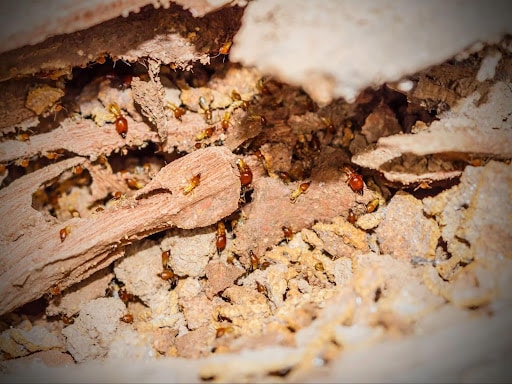Termite Pest Control
Get personalized termite control solutions designed specifically for your property, eliminating active colonies and safeguarding your home from future infestations.

Why choose Hawx for pest control?
Customized
- • Treatment tailored to your needs
- • Plans to meet your budget
- • Comprehensive, ongoing service for the most effective pest control
Tech-driven
- • Latest products and technology
- • Environmentally friendly
- • Smart service report included
Free follow-up service
If pests come back between treatments, so will we—at no additional cost to you.
See what our customers say about us

“Termites build colonies as they set up shop. They scout and find wood in our homes, but that scouting behavior is why baiting stations work so well. The individual termites feed it back into the brood and start spreading the treatment.
Hawx can treat termite problems using a combination of liquid treatment and baiting, in addition to preventative treatments.”
Vice President of Technical & Training Services, Entomologist
Termite Control: How it Works
- Professional Termite Inspection
- Strategic Bait Station Installation
- Customized Liquid Treatments
- Annual Monitoring and Protection
A Hawx termite inspector thoroughly evaluates your property for signs of active termite infestations to determine the most effective treatment strategy for your home.
We install bait stations around your home’s perimeter, approximately every 10 feet. This non-invasive system avoids structural drilling or chemicals and effectively disrupts termite colonies within weeks.
For large infestations, our termite control specialists can provide precise liquid treatment options—including Complete Perimeter and Localized Spot treatments—specifically chosen based on the severity and type of termite infestation identified on your property.
To maintain ongoing defense, our technicians conduct annual follow-up appointments, inspecting bait stations and assessing your property’s conditions to ensure your home stays termite-free long after your initial termite treatment.
(Please note that German cockroach infestations require a separate specialty service and are not included in the General Pest Control (GPC) plan.)

What to Expect with Termite Treatments

When you schedule termite pest control with Hawx, we begin by clearly communicating the process and answering any questions you may have.
1. On the service day, our professional technician conducts an in-depth inspection to identify termite activity and vulnerable areas.
2. Following this inspection, we’ll recommend and perform the targeted termite treatment, installing non-invasive Sentricon bait stations around your property’s perimeter or applying targeted liquid treatments for active infestations.
3. Throughout your service, we’ll ensure minimal disruption to your property, clearly explaining each step so you can understand what’s happening.
4. After treatment, you’ll receive guidance on protecting your home from future termite threats, along with details about our one-year service warranty and annual inspection plans.
When termites threaten your home, Hawx delivers proven solutions and advanced treatments to protect your property from costly damage. Our termite experts design customized plans to eliminate colonies quickly and keep them away permanently. Don’t let termites compromise your home’s integrity—call Hawx today for a free estimate, and get lasting protection for your biggest investment.
FAQs
Does Hawx offer termite inspections?
Yes! A certified termite inspector from Hawx will carefully evaluate your property to identify the type of termites present, including flying termites. Our thorough inspection helps us design a customized treatment approach specific to your home while pinpointing any conditions that may attract termites.
What’s the most effective termite treatment?
The most effective termite treatment depends on the species and extent of infestation. Hawx often recommends a termite baiting system because it eliminates termite colonies underground without injecting chemicals into your soil.
Is pest control effective against termites?
Standard pest control and DIY methods typically won’t eliminate termites since they require specialized treatment methods. For successful termite pest control, it’s important to use targeted strategies like bait stations or liquid treatments designed specifically for subterranean or drywood termites.
How much does professional termite service cost?
The cost of a termite service depends on your home’s size, construction type, and infestation severity. Hawx provides personalized quotes following a comprehensive termite inspection. After assessing your specific situation, we’ll clearly outline the recommended termite control plan and pricing details.
Can Hawx Pest Control eliminate termites from my home?
Yes, we can! Hawx provides effective termite control through detailed inspections and proven treatments. After inspecting your property, our licensed professionals create a custom plan designed to fully address your infestation. After the service, you’ll receive a detailed report (with photos) plus personalized recommendations for ongoing protection.
How often should I have my home inspected for termites?
We recommend scheduling a professional termite inspection annually, even if you haven’t noticed obvious signs of termites. Regular inspections help identify potential issues early, minimizing the risk of severe structural damage and costly repairs by catching infestations before they become widespread.
How quickly will termites damage my home?
Termite damage can go unnoticed for months or even years. However, once they’ve taken up residence, termites can cause massive structural damage quickly. Early detection and professional termite treatment from Hawx are a must for protecting your property and preventing costly repairs down the road. Plus, most insurance companies consider managing termite issues to be part of routine home maintenance.
Read more about Termite Facts

How To Get Rid of Flying Termites
As if regular termites weren’t bad enough, flying termites can be a homeowner’s nightmare. A potential infestation of these winged termites could lead to significant

What is a Termite Inspection?
Are you worried about termites crashing your home sweet home? The signs of termites can be subtle – a tiny pile of wood dust here,

What Do Termites Look Like?
You’re sitting in your cozy living room, sipping on a hot cup of coffee, when you notice it. A minuscule, almost invisible creature crawling along
Visit the pest library to learn more.


